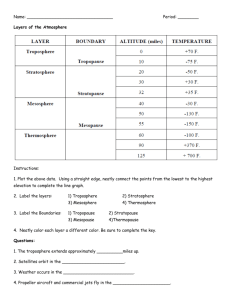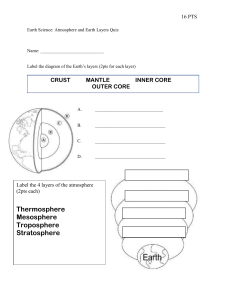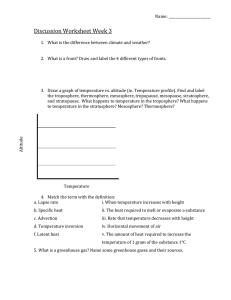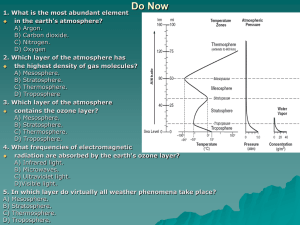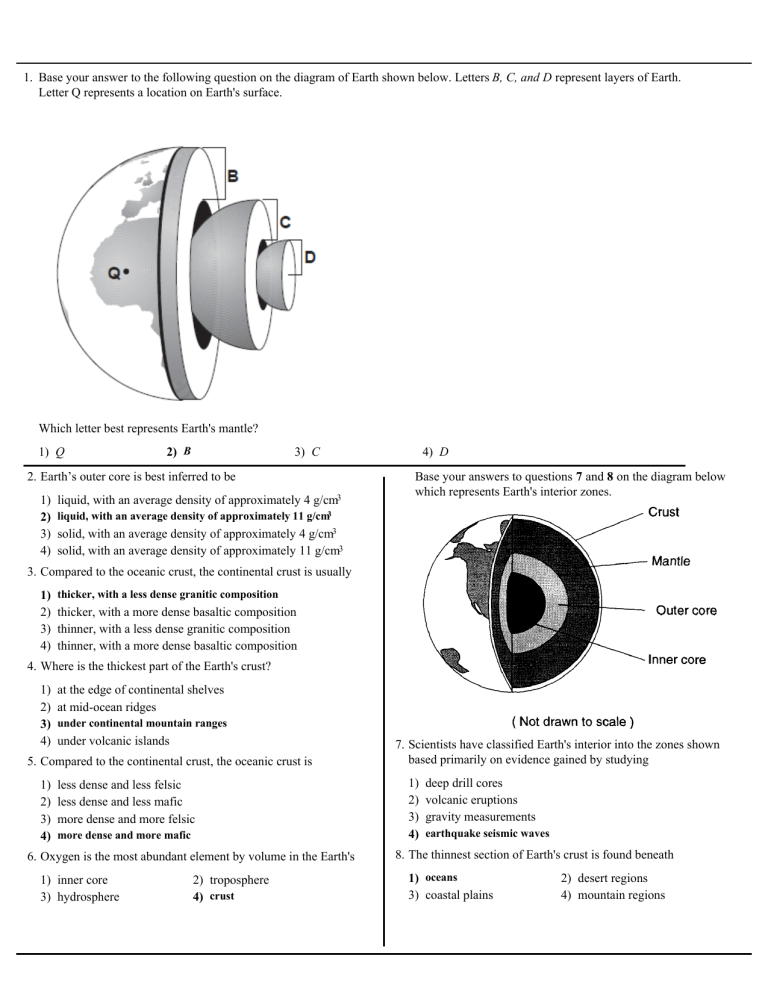
1. Base your answer to the following question on the diagram of Earth shown below. Letters B, C, and D represent layers of Earth. Letter Q represents a location on Earth's surface. Which letter best represents Earth's mantle? 1) Q 2) B 3) C 2. Earth’s outer core is best inferred to be 1) 2) 3) 4) liquid, with an average density of approximately 4 g/cm3 4) D Base your answers to questions 7 and 8 on the diagram below which represents Earth's interior zones. liquid, with an average density of approximately 11 g/cm3 solid, with an average density of approximately 4 g/cm3 solid, with an average density of approximately 11 g/cm3 3. Compared to the oceanic crust, the continental crust is usually 1) 2) 3) 4) thicker, with a less dense granitic composition thicker, with a more dense basaltic composition thinner, with a less dense granitic composition thinner, with a more dense basaltic composition 4. Where is the thickest part of the Earth's crust? 1) 2) 3) 4) at the edge of continental shelves at mid-ocean ridges under continental mountain ranges under volcanic islands 5. Compared to the continental crust, the oceanic crust is 1) 2) 3) 4) less dense and less felsic less dense and less mafic more dense and more felsic more dense and more mafic 6. Oxygen is the most abundant element by volume in the Earth's 1) inner core 3) hydrosphere 2) troposphere 4) crust 7. Scientists have classified Earth's interior into the zones shown based primarily on evidence gained by studying 1) 2) 3) 4) deep drill cores volcanic eruptions gravity measurements earthquake seismic waves 8. The thinnest section of Earth's crust is found beneath 1) oceans 3) coastal plains 2) desert regions 4) mountain regions 9. The pie graph below represents the composition, in percent by mass, of the chemical elements found in an Earth layer. The composition of which Earth layer is represented by the pie graph? 1) crust 2) outer core 3) troposphere 10. What are the inferred pressure and temperature at the boundary of Earth's stiffer mantle and outer core? 1) 1.5 million atmospheres pressure and an interior temperature of 4950°C 2) 1.5 million atmospheres pressure and an interior temperature of 6200°C 3) 3.1 million atmospheres pressure and an interior temperature of 4950°C 4) 3.1 million atmospheres pressure and an interior temperature of 6200°C 11. What caused the interior of Earth to separate into layers? 1) 2) 3) 4) a decrease in the rate of rotation of Earth the gravitational pull on materials of varying densities variations in heating by the Sun due to Earth's tilt collisions with meteors and comets 12. The inferred temperature and pressure of Earth's interior at a depth of 3,000 kilometers are approximately 1) 2) 3) 4) 1000°C and 0.5 million atmospheres 1000°C and 1.0 million atmospheres 5000°C and 1.5 million atmospheres 5000°C and 3.0 million atmospheres 13. The inferred temperature at the interface between the stiffer mantle and the asthenosphere is closest to 1) 1000°C 2) 2500°C 3) 4500°C 4) 5000°C 14. What happens to the density and temperature of rock within Earth's interior as depth increases? 1) 2) 3) 4) density decreases and temperature decreases density decreases and temperature increases density increases and temperature increases density increases and temperature decreases 15. Geologists have used information about the composition of meteorites to make inferences about Earth’s 1) 2) 3) 4) core properties atmospheric structure asthenosphere location continental-crust thickness 4) hydrosphere 16. Which statement best explains why the direction of some seismic waves changes sharply as the waves travel through the Earth? 1) 2) 3) 4) The Earth is spherical. Seismic waves tend to travel in curved paths. The temperature of the Earth's interior decreases with depth. Different parts of the Earth's interior have different densities. 17. From the top of the stiffer mantle to the center of Earth, the rock material is inferred to be 1) solid all the way to the center of the inner core 2) solid, then liquid to the center of the inner core 3) solid, then liquid, then solid again to the center of the inner core 4) solid, then liquid, then gaseous to the center of the inner core 18. The greatest atmospheric pressure occurs in the 1) troposphere 3) mesosphere 2) stratosphere 4) thermosphere 19. Why do most clouds form in the troposphere? 1) Air pressure rises with increasing altitude. 2) The dewpoint is too high in the other layers of the atmosphere. 3) The other layers of the atmosphere are too cold to contain water. 4) The lowest 11 km of the atmosphere contains almost all of the atmospheric water vapor. 20. Which statement best describes the stratosphere? 1) 2) 3) 4) It is warmer at the top than at the bottom. It is located 75 kilometers above sea level. It has greater pressure at the top than at the bottom. It absorbs large amounts of water vapor from the troposphere. 21. Ozone is concentrated in Earth's atmosphere at an altitude of 20 to 35 kilometers. Which atmospheric layer contains the greatest concentration of ozone? 1) mesosphere 3) troposphere 2) thermosphere 4) stratosphere 22. Base your answer to the following question on the passage and cross section below and on your knowledge of Earth science. The cross section represents one theory of the movement of rock materials in Earth's dynamic interior. Some mantle plumes that are slowly rising from the boundary between Earth's outer core and stiffer mantle are indicated. Hot Spots and Mantle Plumes Research of mantle hot spots indicates that mantle plumes form in a variety of sizes and shapes. These mantle plumes range in diameter from several hundred kilometers to 1000 kilometers. Some plumes rise as blobs rather than in a continuous streak; however, most plumes are long, slender columns of hot rock slowly rising in Earth's stiffer mantle. One theory is that most plumes form at the boundary between the outer core and the stiffer mantle. They may reach Earth's surface in the center of plates or at plate boundaries, producing volcanoes or large domes. At which depth below Earth's surface is the boundary between Earth's outer core and stiffer mantle located? 1) 700 km 2) 2000 km 3) 2900 km 23. As a weather balloon released from the surface of Earth rises through the troposphere, the instruments it carries will usually indicate that 1) temperature, atmospheric pressure, and concentration of water vapor decrease 2) temperature decreases, but atmospheric pressure and concentration of water vapor increase 3) temperature increases, but atmospheric pressure and concentration of water vapor decrease 4) temperature, atmospheric pressure, and concentration of water vapor increase 24. In which zone of the atmosphere would a temperature of 95ºC most likely occur? 1) troposphere 3) mesosphere 2) stratosphere 4) thermosphere 25. Which list shows atmospheric layers in the correct order upward from the Earth's surface? 1) 2) 3) 4) thermosphere, mesosphere, stratosphere, troposphere troposphere, stratosphere, mesosphere, thermosphere stratosphere, mesosphere, troposphere, thermosphere thermosphere, troposphere, mesosphere, stratosphere 4) 5100 km Answer Key Earths Layers Checkpoint Questions 1. 2 2. 2 3. 1 4. 3 5. 4 6. 4 7. 4 8. 1 9. 1 10. 1 11. 2 12. 3 13. 2 14. 3 15. 1 16. 4 17. 3 18. 1 19. 4 20. 1 21. 4 22. 3 23. 1 24. 4 25. 2

